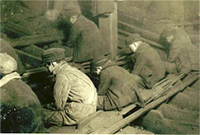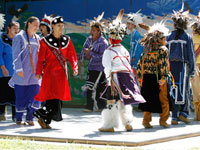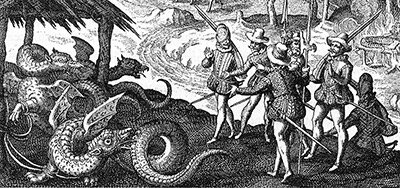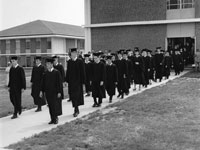1. "… the poisonous weede being in shape but little different from our English yuie, but being touched cause thrednesse, itchinge, and lastly blysters, the which, howsoever, after a while they passe away of themselves without further harme; yet because for the time they are somewhat painefull, and in aspect dangerous, it hath gotten to itselfe an ill name, although questionlesse of noe very ill nature." [1]
What was this plant?
Poison ivy (Rhustoxicodendron).
2. In 1620, Oppenheim printer Theodore de Bry published America, in which he richly illustrated part of The East and West Indian Mirror, a book published the previous year that narrated Georg Spielbergen's expedition in 1614-1617 around the world. The following is one of de Bry's illustrations, showing Europeans in the New World [2]:

What are the animals the men in the foreground are hunting?
Sea Lions (Otaridae).
3. In 1557 in Paris, Andre Thevet published, Singularities de la France Antarctique. It was translated into English and published the following year in London. It described and pictured some of the wildlife of Patagonia, present-day Argentina and Chile. One of the illustrations shows a "su," which Thevet said was "a ravenous beast made after a strange maner." [3]

What was this animal?
A kind of opossum. Specifically, the Elegant Fat-tailed Opossum (Thylamyselegans), native to Patagonia. Captain John Smith would later encounter a Virginia Opossum (Didelphisvirginiana) and describe it this way: "An Opassom hath an headlike a Swine, and a taile like a Rat, and is of the bignesse of a Cat. Under her belly she hath a bagge, wherein she lodgeth, carrieth, and suckeleth her young." [4]
4. Captain John Smith's General Historie of Virginia has the following passage:
"Plums there are of three sorts. The red and white are like our hedge plums, but the other which they call Putchamins, grow as high as a Palmeta: the fruit is like a Medler; it is first greene, then yellow, and red when it is ripe; if it be not ripe, it will draw a mans mouth awry, with much torment, but when it is ripe, it is as delicious as an Apricot." [5]
What is Smith describing?
Persimmons (Diospyrosvirginiana).
5. In 1530, Pietro Martire d'Anghiera, in his De Orbo Novo, wrote of the Indians of Hispaniola (present day Haiti and the Dominican Republic):
"They dygge also owte of the ground certeyne rootes growynge of theimselues, which they caule ____, much lykevnto the nauie rootes of Mylayne, or the greate puffes or musheroms of the earth. Howe sooeuer they bee dressed, eyther fryed or sodde, they gyue place to noo such kynde of meate in pleasant tenderness. The skyn is sumwhat towgher then eyther of nauies or musheroms, and of earthy coloure: But the inner meate thereof, is verye whyte. … They are also eaten rawe, and haue the taste of rawe chestnuttes, but are sumwhat sweeter." [6]
What goes in the blank?
"Botatas," that is, potatoes (Solanumtuberosum). This appears to be the first mention of potatoes in European literature.
6. Miguel de Asua and Robert French, in A New World of Animals: Early Modern Europeans on the Creatures of Iberian America, describe Christopher Columbus's voyages to the New World. Their account of Admiral Columbus's first voyage lists many of the strange flora and fauna that the excited explorer discovered. Their account has this passage:
"But his elated mood probably plunged at the view of what he describes as a 'serpent' seven feet long and one foot wide. The beast escaped and disappeared into a pool, but was speared by the Spaniards and afterwards recovered and skinned. The Admiral, always mindful of the curiosity of his sovereigns about the marvels of nature, set down in his log that he had ordered the skin to be salted and kept in store to be later presented to them. Despite the terrifying appearance of the animal, the newcomers eventually became used to its meat, which had a pleasant flavour." [7].
The following illustration shows the Spaniards hunting these creatures:

What were they?
Iguanas (Iguana iguana).
7. On January 9, 1493 during his first voyage to America, Columbus recorded in his ship's log that, while sailing toward the river he had named the Rio del Oro, he saw three mermaids near the island of Hispaniola. They "came up very high out of the sea." He had seen some before, near the coast of Guinea. He observed that these mermaids "were not as beautiful as they are painted, as in some ways they are formed like a man in the face." [8]
What were these "mermaids" that Columbus saw?
They were almost certainly manatees (Trichechusmanatus).
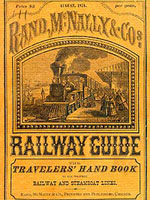
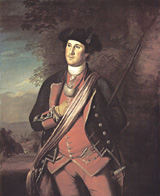
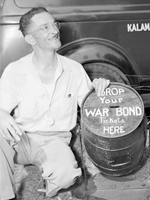
 advances led to the rise of developments around cities. Streetcars, trains, and, later, highways made it possible for workers to commute to urban centers for work and to travel outside of the city for their home life. Suburb development grew exponentially after World War II with the rapid spread of mass-produced housing such as Levittown.
advances led to the rise of developments around cities. Streetcars, trains, and, later, highways made it possible for workers to commute to urban centers for work and to travel outside of the city for their home life. Suburb development grew exponentially after World War II with the rapid spread of mass-produced housing such as Levittown. Americans met their needs by harvesting energy and materials from plants, animals, rivers, and wind. By the 1830s, though, large-scale coal extraction had begun in Pennsylvania, Virginia, and beyond. By the 1910s, more than 750,000 coal miners dug and blasted upwards of 550 million tons of coal a year. Fossil fuels changed daily life in America, from travel to shopping, daily life to leisure. America's industrial ascendancy, however, caused problems for humans and the environment and in 2009, the threat of diminishing supplies is a serious concern.
Americans met their needs by harvesting energy and materials from plants, animals, rivers, and wind. By the 1830s, though, large-scale coal extraction had begun in Pennsylvania, Virginia, and beyond. By the 1910s, more than 750,000 coal miners dug and blasted upwards of 550 million tons of coal a year. Fossil fuels changed daily life in America, from travel to shopping, daily life to leisure. America's industrial ascendancy, however, caused problems for humans and the environment and in 2009, the threat of diminishing supplies is a serious concern.